| dc.contributor.advisor | Leonid Kogan. | en_US |
| dc.contributor.author | Wang, Jiong J. (Jiong John) | en_US |
| dc.contributor.other | Massachusetts Institute of Technology. Dept. of Electrical Engineering and Computer Science. | en_US |
| dc.date.accessioned | 2006-07-13T15:19:59Z | |
| dc.date.available | 2006-07-13T15:19:59Z | |
| dc.date.copyright | 2005 | en_US |
| dc.date.issued | 2005 | en_US |
| dc.identifier.uri | http://hdl.handle.net/1721.1/33385 | |
| dc.description | Thesis (M. Eng.)--Massachusetts Institute of Technology, Dept. of Electrical Engineering and Computer Science, 2005. | en_US |
| dc.description | Includes bibliographical references (leaf 42). | en_US |
| dc.description.abstract | The risk arbitrage investment process involves betting on the outcome of announced mergers and acquisitions. We analyzed a sample of 1309 stock and cash mergers from 1996 to 2004 Q2 and developed insights into the risk arbitrage process. We found share price reactions for both the acquirer and target companies as a result of the merger announcement and compared these to factors such as type of merger, premium paid by the acquirer for the target, relative size of the deal to the size of the acquirer and target, and deal consummation time. We utilized this information to develop a merger return prediction model that predicts a merger's return given various deal characteristics. We constructed several portfolios, one using a trading strategy in which we invest equally in every announced deal, one where we invest only in deals that have a predicted return higher than two times the T-Bills rate, one where we invest in deals that have a predicted return higher than 0, and one where we invest in deals with a predicted return higher than one standard deviation of the predicted returns. A subsequent out of sample analysis of' generating a predicted return model using data from 1996 to 1999 and predicting returns from 2000 to 2004 Q2 produces returns of 4.96%, 3.14%, and 5.87% for our three portfolios compared with 1.74% generated from investing in all deals from 2000 to 20)4 Q2. | en_US |
| dc.description.abstract | (cont.) Our study shows that our strategy focuses mainly on cash deals but our strategy still makes improvements in the Sharpe Ratio despite this limitation. Our analysis provides insights into mergers and how the market prices such deals. Furthermore, the trading strategies employed can be used as a basis for constructing a profitable risk arbitrage trading platform. | en_US |
| dc.description.statementofresponsibility | by Jiong J. Want. | en_US |
| dc.format.extent | 42 leaves | en_US |
| dc.format.extent | 1918814 bytes | |
| dc.format.extent | 1920465 bytes | |
| dc.format.mimetype | application/pdf | |
| dc.format.mimetype | application/pdf | |
| dc.language.iso | eng | en_US |
| dc.publisher | Massachusetts Institute of Technology | en_US |
| dc.rights | M.I.T. theses are protected by copyright. They may be viewed from this source for any purpose, but reproduction or distribution in any format is prohibited without written permission. See provided URL for inquiries about permission. | en_US |
| dc.rights.uri | http://dspace.mit.edu/handle/1721.1/7582 | |
| dc.subject | Electrical Engineering and Computer Science. | en_US |
| dc.title | Research and Development of risk arbitrage trading systems | en_US |
| dc.title.alternative | Risk arbitrage trading systems | en_US |
| dc.type | Thesis | en_US |
| dc.description.degree | M.Eng. | en_US |
| dc.contributor.department | Massachusetts Institute of Technology. Department of Electrical Engineering and Computer Science | |
| dc.identifier.oclc | 62558977 | en_US |
